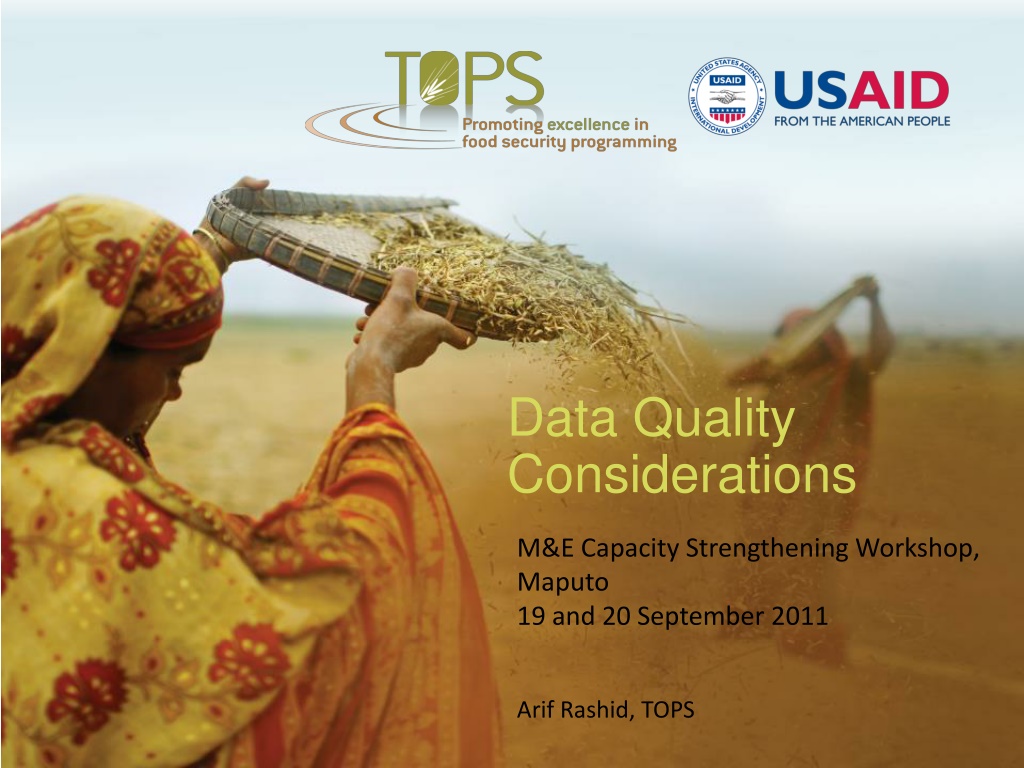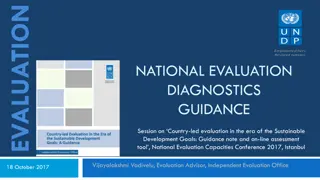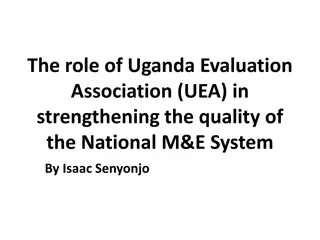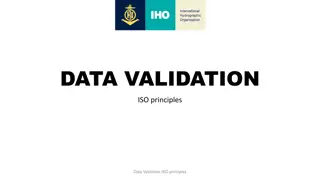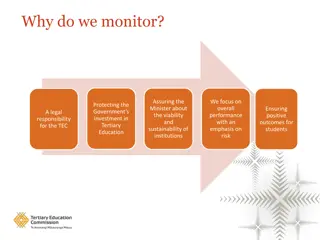Understanding Data Quality Considerations in Monitoring and Evaluation Capacity Strengthening
Explore the importance of data quality in project implementation and management systems. Learn about the dimensions of data quality, including accuracy, completeness, reliability, timeliness, and integrity. Discover the conceptual framework and functional components essential for ensuring data quality in M&E structures.
- Data Quality
- Monitoring and Evaluation
- Capacity Strengthening
- Project Implementation
- Information System
Download Presentation

Please find below an Image/Link to download the presentation.
The content on the website is provided AS IS for your information and personal use only. It may not be sold, licensed, or shared on other websites without obtaining consent from the author. Download presentation by click this link. If you encounter any issues during the download, it is possible that the publisher has removed the file from their server.
E N D
Presentation Transcript
Data Quality Considerations M&E Capacity Strengthening Workshop, Maputo 19 and 20 September 2011 Arif Rashid, TOPS
Data Quality Project Implementation Data Management System An information system represents these activities by collecting the results that were produced and mapping them to a recording system. Project activities are implemented in the field. These activities are designed to produce results that are quantifiable. Data Quality: How well the DMS represents the fact ? Data True picture of the field Management System Slide # 1
Why Data Quality? Program is evidence-based Data quality Data use Accountability Slide # 2
Conceptual Framework of Data Quality? Dimensions of Data Quality Quality Data Accuracy, Completeness, Reliability, Timeliness, Confidentiality, Precision, Integrity Functional components of Data Management Systems Needed to Ensure Data Quality Data management and reporting M&E Unit in the Country Office M&E Structures, Roles and Responsibilities Indicator definitions and reporting guidelines system Intermediate aggregation levels (e.g. districts/ regions, etc.) Data collection and reporting forms/tools Data management processes Data quality mechanisms Service delivery points M&E capacity and system feedback Slide # 3
Dimensions of data quality Accuracy/Validity Accurate data are considered correct. Accurate data minimize error (e.g., recording or interviewer bias, transcription error, sampling error) to a point of being negligible. Reliability Data generated by a project s information system are based on protocols and procedures. The data are objectively verifiable. The data are reliable because they are measured and collected consistently. Slide # 4
Dimensions of data quality Precision The data have sufficient detail information. For example, an indicator requires the number of individuals who received training on integrated pest management by sex. An information system lacks precision if it is not designed to record the sex of the individual who received training. Completeness Completeness means that an information system from which the results are derived is appropriately inclusive: it represents the complete list of eligible persons or units and not just a fraction of the list. Slide # 5
Dimensions of data quality Timeliness Data are timely when they are up-to-date (current), and when the information is available on time. Integrity Data have integrity when the system used to generate them are protected from deliberate bias or manipulation for political or personal reasons. Slide # 6
Dimensions of data quality Confidentiality Confidentiality means that the respondents are assured that their data will be maintained according to national and/or international standards for data. This means that personal data are not disclosed inappropriately, and that data in hard copy and electronic form are treated with appropriate levels of security (e.g. kept in locked cabinets and in password protected files. Slide # 7
Data quality Assessments Project participants Managers Technicians Field staff Partners Local Govt. Headquarters Slide # 8
Data quality Assessments Two dimensions of assessments: 1. Assessment of data management and reporting systems 2. Follow-up verification of reported data for key indicators (spot checks of actual figures) Slide # 9
Systems assessment tools Are key M&E and data-management staff identified with clearly assigned responsibilities? M&E structures, functions and capabilities 1 Have the majority of key M&E and data management staff received the required training? 2 Are there operational indicator definitions meeting relevant standards that are systematically followed by all service points? Indicator definitions and reporting guidelines 3 Has the project clearly documented what is reported to who, and how and when reporting is required? 4 Are there standard data-collection and reporting forms that are systematically used? Data collection and reporting forms/tools 5 Are data recorded with sufficient precision/detail to measure relevant indicators? 6 Are source documents kept and made available in accordance with a written policy? 7 Slide # 10
Systems assessment tools Does clear documentation of collection, aggregation and manipulation steps exist? Data management processes Are data quality challenges identified and are mechanisms in place for addressing them? Are there clearly defined and followed procedures to identify and reconcile discrepancies in reports? Are there clearly defined and followed procedures to periodically verify source data? Do M&E staff have clear understanding about the roles and how data collection and analysis fits into the overall program quality? M&E capacity and system feedback Do M&E staff have clear understanding with the PMP, IPTT and M&E Plan? Do M&E staff have required skills in data collection, aggregation, analysis, interpretation and reporting ? Are there clearly defined feedback mechanism to improve data and system quality? Slide # 11
Schematic of follow-up verification Slide # 12
M&E system design for data quality Appropriate design of M&E system is necessary to comply with both aspects of DQA Ensure that all dimensions of data quality are incorporated into M&E design Ensure that all processes and data management operations are implemented and fully documented (ensure a comprehensive paper trail to facilitate follow-up verification) Slide # 13
This presentation was made possible by the generous support of the American people through the United States Agency for International Development (USAID). The contents are the responsibility of Save the Children and do not necessarily reflect the views of USAID or the United States Government.
